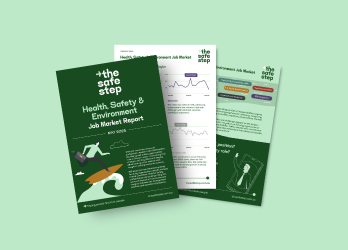Are you hiring a HR & HSE workforce for the future, or the past?
Page Published Date:
August 6, 2025
Your HR & HSE hiring decisions reveal whether you're building teams for today's integrated workplace challenges or yesterday's siloed approach. Most organisations are still recruiting the same way they did five years ago, while others are adapting to new realities.

Past or future thinking?
The way you've always hired for People and Safety roles tells a story about where your organisation is headed. Traditional recruitment practices focus on past experience and functional expertise. Future-focused hiring looks for adaptive capability and cross-functional thinking.
Most job descriptions still read like they were written in 2019. They demand years of experience in specific areas and university degrees that don't prepare people for today's workplace realities. These descriptions ignore the fact that modern workplace challenges cross departmental lines. Ask yourself: does that degree requirement predict future success, or are you focusing on what looks good on paper?
Every HR & HSE hiring decision you make can reinforce old silos, or build new capabilities that position your organisation ahead of regulatory and cultural shifts reshaping the workplace.
Hiring for yesterday's problems
When you recruit an HR manager with zero understanding of risk assessment, you're hiring for the past. When you select a safety professional who can't navigate performance conversations or interpret data insights, you're building yesterday's team for tomorrow's challenges.
The cost isn't just theoretical. These hiring decisions create compliance vulnerabilities and missed opportunities that compound over time. An HR leader who doesn't recognise safety implications delays crucial interventions. A safety manager without people skills or data literacy struggles to influence cultural change in an increasingly tech-driven workplace.
Consider what this means for capability building. Every senior hire influences dozens of decisions and shapes team development for years. The wrong hiring focus today creates teams that simply can't adapt to evolving workplace demands.
Future roles blur boundaries
Future-focussed organisations are creating positions that didn't exist two years ago. Roles like "Head of People Care" deliberately integrate traditionally separate functions. These positions acknowledge that workplace risks now sit squarely at the intersection of people and safety concerns.
Modern HR and safety leaders aren't just navigating technological and societal workplace changes—they're helping the broader workforce adapt too. This demands soft skills that set leaders apart: strategic thinking, business acumen, effective influence and being data-informed alongside technical expertise.
The best candidates are already developing cross-functional capabilities. Businesses are increasingly seeking diverse skillsets—from communications and data analytics to AI expertise and human factors specialists—to complement existing technical knowledge.
Your talent competition includes organisations actively seeking these hybrid skills. They're rewriting position descriptions to attract candidates who think beyond functional silos. If your recruitment still mirrors 2019 thinking, you're attracting yesterday's professionals while tomorrow's leaders go elsewhere.
Recruiting for tomorrow's challenges
Start by questioning your role design assumptions. Instead of defining positions by historical precedent, design them around future requirements. Consider challenges like AI integration, an ageing workforce and evolving mental health needs that will require both HR and safety expertise working together.
Skills-based hiring offers real opportunities here. Focus on capabilities rather than job titles when evaluating candidates. Someone with change management experience in technology implementation might excel in safety leadership despite lacking traditional HSE credentials. However, avoid the pitfall of undervaluing foundational expertise—technical knowledge still matters, especially in high-risk environments.
Rewrite position descriptions to emphasise cross-functional collaboration as essential, not optional. Include experience working across traditional boundaries as a core requirement. Seek candidates who've navigated integrated projects or demonstrated systems thinking in previous roles.
Transform your interview process to explore adaptive capabilities alongside technical skills. Ask candidates about times they've worked outside their comfort zone or collaborated across departments. Look for evidence of intellectual curiosity and comfort with evolving responsibilities—especially important when traditional development pathways are becoming less defined.
Choose future-focused talent
Partner with recruiters who understand this evolution. The Next Group's combined expertise across The Next Step and The Safe Step means accessing candidates who've already developed integrated capabilities. We're tracking talent market shifts and know where to find professionals who think beyond traditional silos.
Prioritise candidates who've volunteered for cross-functional projects or pursued learning outside their primary discipline. These professionals demonstrate the intellectual curiosity and adaptability that future-focused roles demand. With increasing competition for emerging skillsets, identifying these adaptive professionals becomes crucial.
Building this capability internally matters too. Consider structured development programmes like HSE Amplify that help existing team members develop the strategic thinking and cross-functional skills tomorrow's integrated roles require.
Listen carefully to the questions candidates ask during interviews. The best ones inquire about collaboration structures, integrated reporting and cross-functional success measures. They're already thinking like the adaptive leaders your organisation needs for tomorrow's challenges.
Build your future workforce today
Evolving to future-ready hiring creates a significant competitive advantage. While others cling to traditional job descriptions and siloed thinking, you can build the integrated workforce that tomorrow's challenges demand.
Your hiring decisions today determine whether you're preparing for old problems or new opportunities. Choose the future. Choose candidates who can bridge traditional boundaries and evolve with changing requirements. The past is comfortable, but the future belongs to those bold enough to hire for what's coming, not what's been.




